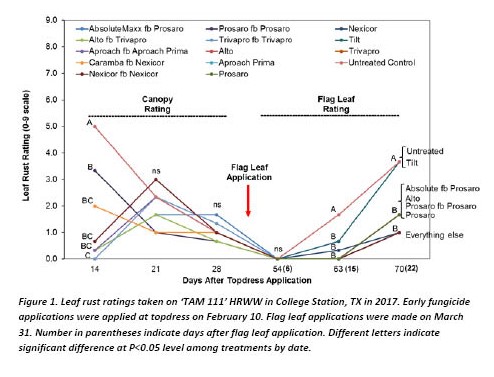by Dr. Clark Neely, Statewide Small Grains Extension Specialist, Texas A&M AgriLife Extension
Dr. Tom Isakeit, Extension Field Crops Pathologist, Texas A&M AgriLife Extension
Despite the wet, dreary weather some parts of the state have experienced over the past few weeks, rust levels appear to be low at this time for most of the wheat acres in the state. However, I still receive questions on whether a topdress or pre-flag leaf application of fungicide is a good idea. In most cases, the answer is “no”, an early fungicide application will not pay for itself. However, as mentioned in previous Row Crops Newsletter articles, heavy stripe rust pressure can warrant early fungicide applications, particularly when cool, wet weather is in the forecast to facilitate further disease development. Limited data is available on the impacts powdery mildew has on yield.
Data generated from wheat fungicide trials in College Station, TX the past two years indicate yield response from early fungicide (pre-flag leaf) applications are unlikely when leaf rust is the primary disease threat. In 2017, mild winter conditions lead to abundant leaf rust in wheat in the trial throughout the winter season. While early fungicide treatments applied at topdress (February 10) did reduce leaf rust pressure in the canopy initially, rust ratings on the flag leaf only 15 days after leaf emergence were no different between the plots receiving both a topdress and flag leaf fungicide and those that received fungicide only at flag leaf (Figure 1).
If applying a fungicide at topdress or pre-jointing, keep in mind that fungicides have grazing restrictions. Many labels require a 7 day interval between application and grazing or haying forage, but check product label before doing so.
While yield was not obtained from this trial, it is recognized that the majority of yield comes from photosynthetic activity in the flag leaf and disease presence on this leaf is a good indicator of potential yield loss. Of the products applied, only Tilt (propiconazole) did not reduce leaf rust pressure 22 days after application (though it did reduce pressure 15 DAA). Statistically, all products performed similarly 22 days out. In 2016, we founds similar results where Tilt performed similarly to other products two weeks after flag leaf application, but was no different than the untreated control four weeks out (Figure 2). Interestingly, the Caramba topdress application (with no subsequent flag leaf application) did reduce flag leaf rust pressure slightly two weeks after flag leaf, but made no difference four weeks out.
On a separate note, some producers may be tempted to not apply any fungicides this season due to low wheat prices. Based on harvested fungicide trials from previous years, when yield potential is over 20 bu/a and leaf rust pressure is moderate or higher, even the lowest yield responses have been 7 bu/a and the highest response has been 26 bu/a on a susceptible variety. When applying an expensive fungicide at $20 per acre at $3.50 per bushel wheat price, a producer needs to generate a 6 bu/a yield response to cover the cost of application. This is certainly possible on a susceptible variety with enough rust pressure and the yield response needed will shrink as wheat prices creep up as shown in Figure 3.
Cheaper triazole products may only cost $5 per acre (product plus application cost), but will generally only provide a 2-3 week window of protection and not generate as much yield response without a subsequent fungicide application. Regardless, one constant remains: flag leaf emergence (Feekes 9) remains the most critical timing for fungicide applications in wheat.
As winter wheat is rapidly coming out of winter dormancy in northern parts of the state and even approaching flag leaf emergence in southern and central regions, producers are encouraged to consider these points (as well as varietal resistance) when deciding whether to apply a fungicide this season or not. Of course disease pressure plays a major role in this decision and producers must pay attention to disease reports from around the state as well as extended forecasts which may facilitate or slow down the spread of fungal pathogens. While stripe rust has been confirmed in Uvalde and College Station research plots there are currently no confirmed reports in producer fields in the state. Leaf rust is present, but at low levels, as is expected for this time of year. It would appear that this would be of greater concern at this point than stripe rust as it thrives in warmer temperatures. But again, weather conditions will be a driving factor.
For detailed results on fungicide trials, as well as disease characteristics of varieties, go to http://varietytesting.tamu.edu/wheat.

Clark Neely
State Small Grains Agronomist
College Station, TX
cneely@ag.tamu.edu


